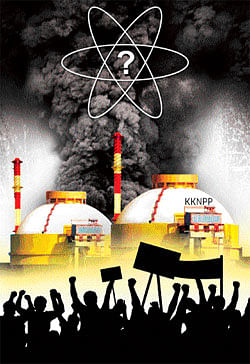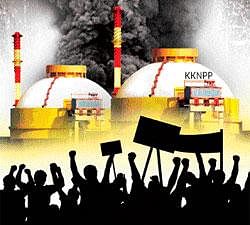
It is the classical dichotomy between highly specialised domain knowledge and the ‘aam admi’s’ perception of it which is in full play here.
This paradox was beautifully captured by the well known modern philosopher of science Michael Polanyi, when he opined that a “democratic assessment of science” is logically impossible. For, practitioners of science, with their knowledge and skills, are privileged to be closer to the truth.
But this is precisely what thousands of vulnerable but now better informed villagers - an offshoot of the IT-Communication revolution - in this oppressively dry Radhapuram taluk of Tamil Nadu’s Tirunelveli district, are vociferously questioning, as they demand the closure of their next-door nuclear enigma - the Kudankulam Nuclear Power Project (KNPP) here.
The broad-based ‘struggle committee’ against KNPP, spearheaded by anti-nuclear activists, S P Udhyakumar and Anton Gomez, have just ended a heroic 12-day long fast, thanks to a politically sagacious Chief Minister J Jayalalitha passing a Cabinet resolution, urging Prime Minister Manmohan Singh to suspend all work at KNPP until the local people’s apprehensions are fully allayed.
Equally, what turned the nation’s eyes towards an obscure ‘pandal’ overlooking the 110-year-old Saint Lourdes catholic church, the fasting venue at Idinthakarai coastal hamlet, 2 km north of the KNPP site, was the sudden upsurge of thousands of people from neighbouring districts including children and disabled, whose solidarity for the fasters bellowed like the boiling sea along this fragile 2004 tsunami-hit coastal stretch.
How come a motley crowd of fasters in a little known village suddenly took centre-stage? It cannot all be put down to anti-nuclear NGOs’ getting hyper-active overnight or committed social activists like Medha Patkar visiting them on a morale-boosting mission.
‘The affected people’s emotive response looks sudden, but this has been simmering from the late 1980s’,” says Father James Peter, pastor of a local parish. “Irrespective of caste, creed or religion, it is now a people’s fight for their survival and cultural identity,” he said.
The KNPP, initially envisaged to set up two 1000 MW each ‘VVER type’ light water reactors, traces its origin to an ‘Inter-Government Agreement’ signed in November 1988 by then Prime Minister Rajiv Gandhi and the then Soviet Union President, Mikhail Gorbachev (before USSR broke up into the Russian Federation). After long years in limbo the reactors were built from September 2001 by the Nuclear Power Corporation of India (NPCIL) and ‘AtomstroyExport’, the export wing of Russia’s State nuclear agency, ‘Rosotom’. The first unit was to go critical in November 2011.
Upcoming & proposed nuclear power plants
Observers are intrigued about the triggers for such a massive protest at this critical juncture, when the civil works have been almost completed and both the reactors were close to start commercial production of electricity within a gap of two to three months.
But a cross-section of villagers demolish all conspiracy theories. “The people of Idinthakarai have been fighting this project, though a section in Kudankulam was divided as they got contract jobs from the project,” says Fr James.
Nonetheless, what turned the tide totally against the KNPP was a “huge, shaking noise, rattling the entire populace when the turbine’s test-run was done recently,” he said. Soon people’s universal refrain was, “how will it be when the nuclear plant actually runs?”, prompting the fast.
“That thundering turbine vibration was felt right up to Uthankudi village, 5 km from here; Won’t we but be scared, particularly after the recent nuclear disaster in Fukushima in Japan?” fumed a retired woman school teacher, at the fasting venue. “Our one-point demand is this nuclear plant should be closed down,” echoed several women protestors.
And following this episode, when the Atomic Energy Commission chairman Srikumar Bannerjee made a statement in Coimbatore that the first Kudankulam unit would start functioning by September 2011, “people’s fears turned into a scare,” contends Gomez.
The scare peaked to a fear psychosis in August, when officials unimaginatively publicised the do’s and don’ts of an off-site ‘Emergency Preparedness Drill’. “Word went round that we have to gag our mouths with black cloth and vacate our homes; monitoring radioactive leak was up to a radius of 30 km, going almost up to Kanniyakumari,” a dismayed soul said.
From head to toe rules were flouted in building these reactors, which casts a doubt on the plant’s resilience to earthquakes or any radioactive leak, alleged locals in Kudankulam. “Shoddy construction and use of low quality pipes in the piping systems outside the reactor building, won’t make them last even for a year and a radioactive leak is imminently possible,” claimed a worker who worked in the plant, with almost an insider’s certainty.
“Even Atomic Energy Regulatory Board guideline prohibiting any quarrying activity within 3 km of the plant site was given the go-by,” regretted Selvan, a farmer, pained by memories that initial hopes of employment and prosperity to Kudankulam area have all been belied.
“Nearly 25 years back they acquired 3,200 acres of land for this nuclear project; but there are still people who are yet to get their compensation,” said Durairaj, another farmer. With those lands, not only hundreds of cash-earning tamarind and Palmyra trees were gone, also “our age-old cotton cultivation was ruined,’ he cried. Pleas to enhance the land compensation met with stiff resistance and “false cases were foisted on us,” he rued.
After a stage, the land compensation money was deposited with the Revenue authorities, involving a hefty lawyer’s fee for any recovery proceeding, the farmers pointed out. “At least if they had deposited that money in a bank, it would have fetched some interest for us,” they felt.
“We won’t rest until the 160 cylinders of enriched Uranium that has come from Russia (as fuel for the N-units) are shipped back,” screamed fisher-folk, who worry about the dwindling sea catches already. Fears of more incidences of cancer in women and birth deformities in kids also haunt them. “Our fast has ended, but our struggle will continue until the nuclear plant is shut down,” said Udhyakumar.
Shaken by these developments, officials of DAE, NPCIL and KNPP have gone into top gear, revamping their out-reach efforts to convince the local people on all issues including safety of the reactors supplied by Russia.
